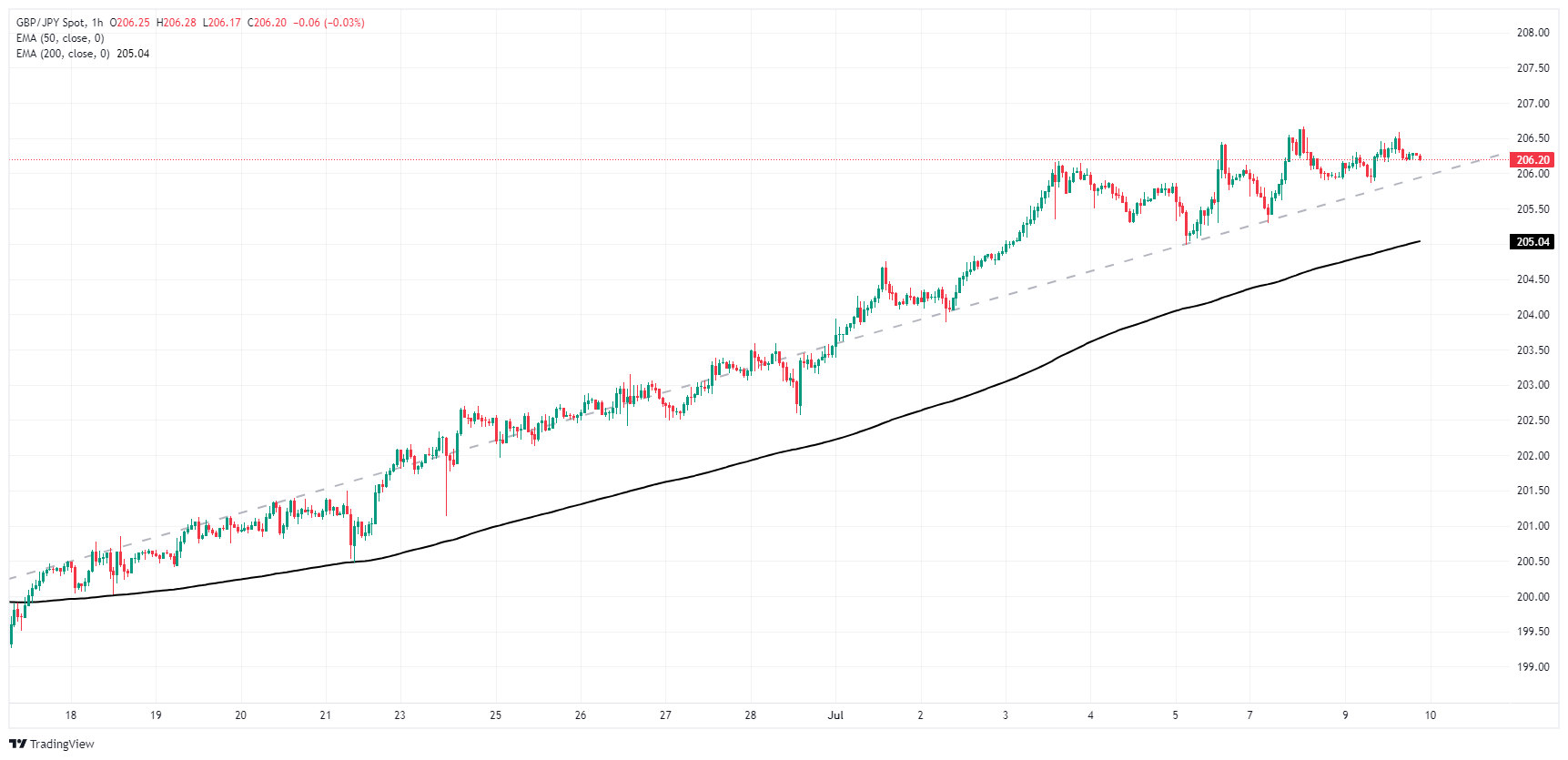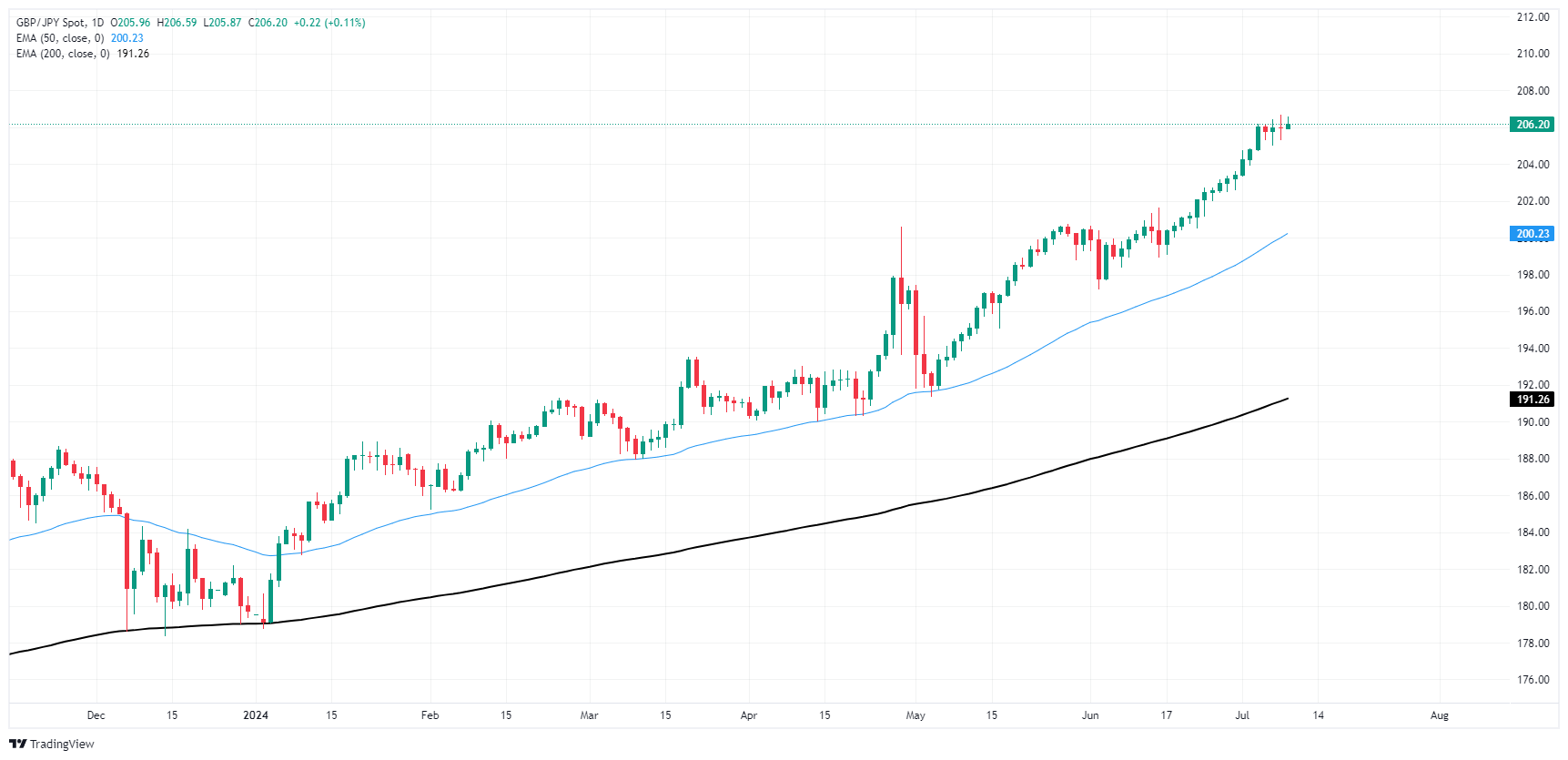- Analiza
- Novosti i instrumenti
- Vesti sa tržišta
- GBP/JPY takes a breather at the top end of stellar run
GBP/JPY takes a breather at the top end of stellar run
- GBP/JPY churns the waters just north of 206.00.
- UK and Japan data remain limited this week, market flows set to continue.
- UK industrial and manufacturing output figures due later in the week.
GBP/JPY failed to set a new multi-year high on Tuesday as the pair churns on the high end of the 206.00 handle. Long-running Yen weakness has left the pair stuck in the rafters of its highest prices in 16 years.
Data remains thin this week for the Japanese Yen (JPY), but broader markets continue to keep an eye out for any signs of direct market intervention from the Bank of Japan (BoJ) that have routinely lamented the Yen’s poor performance against the majority of its major currency peers. However, a rock-bottom Japanese reference rate and a still-wide rate differential between the Yen and the rest of the major currency bloc has left the JPY with little direction to move but down.
UK data is strictly mid-tier this week, with GBP traders looking ahead to Industrial and Manufacturing Production figures due in the back half of the trading week on Thursday. A couple of appearances from Bank of England (BoE) policymakers are slated for early Wednesday but are not expected to rock the policy boat.
Thursday’s UK Industrial Production in May is expected to rebound to 0.2% MoM from the previous month’s -0.9% contraction, and UK Manufacturing Production is forecast to recover 0.4% MoM from the previous -1.4% decline.
GBP/JPY technical outlook
GBP/JPY fell away from fresh 16-year highs above 206.50 set earlier in the week, settling back into familiar intraday territory at the 206.00 handle. Technical pressure is still firmly pinned into the bullish side, but topside momentum is showing signs of petering out, and progress in swing highs is slowly rapidly as bidders run out of gas.
Spinning top daily candles are getting priced into the Guppy charts, and traders should be on the lookout for a retreat to the 50-day Exponential Moving Average (EMA) near 200.00. Despite odds of a near-term pullback, the long-term trend heavily favors the bulls, and a rebound from major technical levels could be on the cards looking forward.
GBP/JPY hourly chart
GBP/JPY daily chart
Pound Sterling FAQs
The Pound Sterling (GBP) is the oldest currency in the world (886 AD) and the official currency of the United Kingdom. It is the fourth most traded unit for foreign exchange (FX) in the world, accounting for 12% of all transactions, averaging $630 billion a day, according to 2022 data. Its key trading pairs are GBP/USD, aka ‘Cable’, which accounts for 11% of FX, GBP/JPY, or the ‘Dragon’ as it is known by traders (3%), and EUR/GBP (2%). The Pound Sterling is issued by the Bank of England (BoE).
The single most important factor influencing the value of the Pound Sterling is monetary policy decided by the Bank of England. The BoE bases its decisions on whether it has achieved its primary goal of “price stability” – a steady inflation rate of around 2%. Its primary tool for achieving this is the adjustment of interest rates. When inflation is too high, the BoE will try to rein it in by raising interest rates, making it more expensive for people and businesses to access credit. This is generally positive for GBP, as higher interest rates make the UK a more attractive place for global investors to park their money. When inflation falls too low it is a sign economic growth is slowing. In this scenario, the BoE will consider lowering interest rates to cheapen credit so businesses will borrow more to invest in growth-generating projects.
Data releases gauge the health of the economy and can impact the value of the Pound Sterling. Indicators such as GDP, Manufacturing and Services PMIs, and employment can all influence the direction of the GBP. A strong economy is good for Sterling. Not only does it attract more foreign investment but it may encourage the BoE to put up interest rates, which will directly strengthen GBP. Otherwise, if economic data is weak, the Pound Sterling is likely to fall.
Another significant data release for the Pound Sterling is the Trade Balance. This indicator measures the difference between what a country earns from its exports and what it spends on imports over a given period. If a country produces highly sought-after exports, its currency will benefit purely from the extra demand created from foreign buyers seeking to purchase these goods. Therefore, a positive net Trade Balance strengthens a currency and vice versa for a negative balance.
© 2000-2024. Sva prava zaštićena.
Sajt je vlasništvo kompanije Teletrade D.J. LLC 2351 LLC 2022 (Euro House, Richmond Hill Road, Kingstown, VC0100, St. Vincent and the Grenadines).
Svi podaci koji se nalaze na sajtu ne predstavljaju osnovu za donošenje investicionih odluka, već su informativnog karaktera.
The company does not serve or provide services to customers who are residents of the US, Canada, Iran, The Democratic People's Republic of Korea, Yemen and FATF blacklisted countries.
Izvršenje trgovinskih operacija sa finansijskim instrumentima upotrebom marginalne trgovine pruža velike mogućnosti i omogućava investitorima ostvarivanje visokih prihoda. Međutim, takav vid trgovine povezan je sa potencijalno visokim nivoom rizika od gubitka sredstava. Проведение торговых операций на финанcовых рынках c маржинальными финанcовыми инcтрументами открывает широкие возможноcти, и позволяет инвеcторам, готовым пойти на риcк, получать выcокую прибыль, но при этом неcет в cебе потенциально выcокий уровень риcка получения убытков. Iz tog razloga je pre započinjanja trgovine potrebno odlučiti o izboru odgovarajuće investicione strategije, uzimajući u obzir raspoložive resurse.
Upotreba informacija: U slučaju potpunog ili delimičnog preuzimanja i daljeg korišćenja materijala koji se nalazi na sajtu, potrebno je navesti link odgovarajuće stranice na sajtu kompanije TeleTrade-a kao izvora informacija. Upotreba materijala na internetu mora biti praćena hiper linkom do web stranice teletrade.org. Automatski uvoz materijala i informacija sa stranice je zabranjen.
Ako imate bilo kakvih pitanja, obratite nam se pr@teletrade.global.















